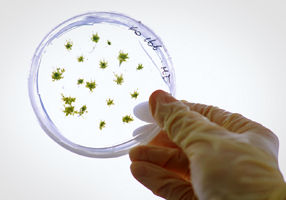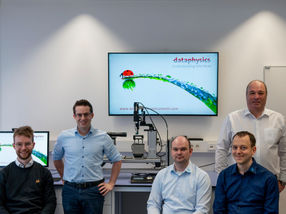How to get rid of proteins
Scientists discover substrates for targeted protein degradation
All life forms depend on proteins which are encoded by genes. Whereas the regulation of protein amounts and activities is analysed in many laboratories, the signals that lead to a regulated degradation of specific proteins are far less well understood. A German team led by the Freiburg-based biologist Professor Ralf Reski has discovered substrates and interaction partners of the so-called N-end rule pathway of protein degradation in the moss Physcomitrella patens.

Physcomitrella patens moss plants in a petri dish.
Sigrid Gombert
From previous research it was evident that an enzyme called ATE flags proteins with the amino acid arginine and that these arginylated proteins are subsequently degraded by the proteasome. “In humans, mice and flies ATE function is essential. Without it, embryos die”, Reski says. His team had previously discovered that the moss Physcomitrella patens is more robust, as loss of ATE function affects development and energy storage but does not result in moss plants dying. Although the N-end rule pathway of protein degradation was discovered in 1986, it was unclear which proteins are flagged by ATE in plants.
For their current study the team from the Plant Biotechnology department of the University of Freiburg co-operated with Professor Andreas Schlosser and his group from the Rudolf Virchow Center for Experimental Biomedicine of the University of Würzburg.
Together, they developed novel methods in immuno-precipitation and mass spectrometry of arginylated proteins and found five needles in the haystack: After analysing about thirty thousand protein spectra the scientists identified four specific proteins that are flagged by ATE and a small heat shock protein that may act as a molecular chaperone to support ATE function. “Our results provide mechanistic insights into the targeted protein degradation in plants”, Reski says. “They may also help to increase the production of human proteins in moss.” Recently, the first moss-made human protein received the approval of the German regulatory authority BfArM for clinical trials.
Original publication
Sebastian N.W. Hoernstein, Stefanie J. Mueller, Kathrin Fiedler, Marc Schuelke, Jens T. Vanselow, Christian Schüssele, Daniel Lang, Roland Nitschke, Gabor L. Igloi, Andreas Schlosser, Ralf Reski; "Identification of targets and interaction partners of arginyl-tRNA protein transferase in the moss Physcomitrella patens"; Molecular and Cellular Proteomics; 2016
Other news from the department science
Most read news
More news from our other portals
See the theme worlds for related content
Topic World Mass Spectrometry
Mass spectrometry enables us to detect and identify molecules and reveal their structure. Whether in chemistry, biochemistry or forensics - mass spectrometry opens up unexpected insights into the composition of our world. Immerse yourself in the fascinating world of mass spectrometry!

Topic World Mass Spectrometry
Mass spectrometry enables us to detect and identify molecules and reveal their structure. Whether in chemistry, biochemistry or forensics - mass spectrometry opens up unexpected insights into the composition of our world. Immerse yourself in the fascinating world of mass spectrometry!

























































